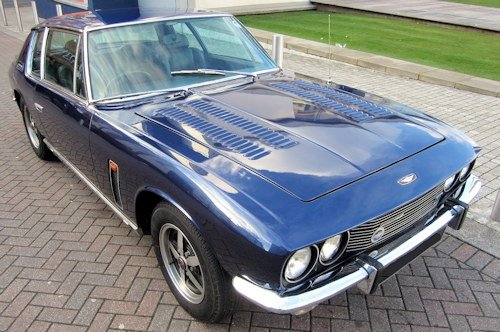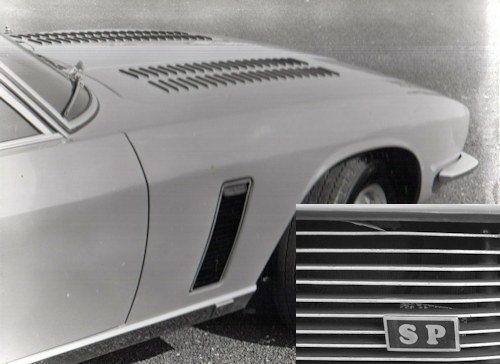Jensen SP
 |
|
|
Production : |
1971-1973 |
|
Class : |
sports car |
|
Body versions : |
Coupé |
|
Engines: |
Gasoline : 7.2 liters (246 kW) |
|
Length: |
4775 mm |
|
Width: |
1750 mm |
|
Height: |
1350 mm |
|
Wheelbase : |
2670 mm |
|
Curb weight : |
1800 kg |
The Jensen SP was a sports car of the British car manufacturer Jensen Motors , which was produced from 1971 to 1973 with only 272 made.
History
The Jensen SP was unveiled at the Earls Court Motor Show in London in October 1971. The purchasing price was GBP 7,195.15 at the time. It cost £450 more than an Interceptor. As a result, the SP was priced nearly identically to the AC 428 with Ford technology. A Chrysler Bristol 411 with a 6.3-liter engine priced £ 7,795, an Aston Martin V8 cost £ 8,949, and a Rolls-Royce Corniche cost £ 13,777.
The car was externally nearly identical to the Jensen Interceptor that was also made at the time, although it had a different engine. SP stood for "Six Pack," and she was referring to the carburetor setup.
The car was produced from October 1971 to July 1973. During this time, 271 vehicles were created. In October 1973 Jensen completed a last SP on request of a customer, so that the total production comprised 272 vehicles.
The Jensen SP was predominantly with right-hand drive. Only 13 vehicles were factory delivered with left-hand drive. 216 vehicles were sold in the UK, eight in Switzerland, two in Australia and one each in the Federal Republic of Germany, the Channel Islands, New Zealand, the Netherlands, Spain and the USA.
Jensen Motors was a body shop that mostly produced car bodies for large-scale manufacturers but also built whole vehicles on occasion. Jensen has been producing cars since the 1950s, including the Austin Healey and later the Sunbeam Alpine. Furthermore, Jensen developed premium sports vehicles under their own name on a small scale, using independent bodywork mixed with British or American high-volume production technology. Jensen has offered the Interceptor, a two-door hatchback coupe with a Chrysler eight-cylinder engine, since 1966.
Derived from the Jensen FF, an externally very similar coupe with innovative all-wheel drive , which represented the top model in Jensen's product range. The very expensive FF was produced only 320 times in four years. In 1971 Jensen discontinued the elaborate and uneconomic production of the FF.
The role of the top model then took over the newly introduced SP, the almost completely coincided technically and externally with the continued to produce Interceptor, but was significantly more motorized.
The SP was formally not a special version of the Interceptor, but was marketed by Jensen as an independent model. The SP was not an economic success. Although it was much cheaper to produce than the FF; The engine was not unproblematic, and the very high consumption and related to the engine technical and practical problems made the SP after the outbreak of the 1973 oil crisis unattractive for customers. During the year 1973, Jensen discontinued the production of the SP.
Jensen took over the chassis, the chassis and the body of the Jensen Interceptor Series 3 without changes. SP and Interceptor had the same tubular frame chassis with which the steel body was welded. Even the 1966 designed by Touring coupe body has not changed. New only two rows of vent openings, ranging over the entire bonnet, were and a synthetic leather related roof. The interior had been upgraded by a central locking and air conditioning, which, unlike the Interceptor here standard equipment included.
The key differentiator was the engine. The Interceptor S3 was introduced in 1971 with a 6.3-liter eight-cylinder engine from Chrysler, the SP had a eight-cylinder engine with 7.2 liters (440 cubic inches) displacement. For mixture preparation three Holley double carburettors were planned; From this configuration, the term "Six Pack" is derived. The engine was at a ratio of 10.3: extraordinary high compression for that time. Due to the high compression ratio of SP gasoline needed with a knock resistance of 100 octane . The maximum output of the engine was given as 385 hp gross or 330 hp net (246 kW), the maximum torque was 556 Nm and started at 3600 revolutions per minute.
In regular driving, only one of the three double carburettors worked. With strong acceleration and at speeds of more than 170 km / h, the other two carburetors switched on. For power transmission was exclusively an automatic three-speed transmission from Chrysler (TorqueFlite type); a gearbox with manual transmission was not offered.Jensen took over the engine block of the SP 1973 for the regular Interceptor S3, but then combined it with a simple "Thermoquad" four-way carburetor from Carter .
A top speed of 225 km / h (140 mph) and for the acceleration of 0 to 96 km / h (60 mph), a value of 7.6 seconds. The top speed was only 2 mph above that of the Interceptor S3 with the 6.3-liter engine. The average fuel consumption was 28 liters per 100 km (11 mpg). The acceleration from 0 to 96 km / h (60 mph) succeeded in 7.4 seconds.
The motorization of the SP resulted in numerous problems in practical operation, which hindered the success of the model. Many customers later upgraded the SP to the Carter carburettor of the regular Interceptor S3, with the intention of increasing the car's suitability for everyday use.
- The handling was particularly problematic when in addition to the first carburetor the other two carburetor switched; that was particularly true when it happened when accelerating out of curves. It was very difficult to predict the exact time to add power and its exact magnitude.
- The large engine led to thermal problems in the engine compartment of the Jensen, which was significantly narrower than the American vehicles in which the engine was usually used. The radiators were not adequately dimensioned, so it quickly came to overheating, which caused consequential damage in the engine environment. The SP was maintenance intensive. The work prescribed an inspection interval of 4000 miles or three months.
- The interaction of the carburettor was difficult to coordinate. One source reports that carburetor recalibration was required on average once a month (or every 500 kilometers).
- The fuel consumption of the SP was also very high compared to similar vehicles from the same market segment. In practice, the SP's average fuel consumption was 28 liters per 100 km (11 miles per gallon ), other sources believed that consumption averaged 35 liters per 100 km (8 miles per gallon) was realistic. Due to the higher weight of the engine, the SP was only marginally faster than the Interceptor with the lighter 6.3-liter engine.

